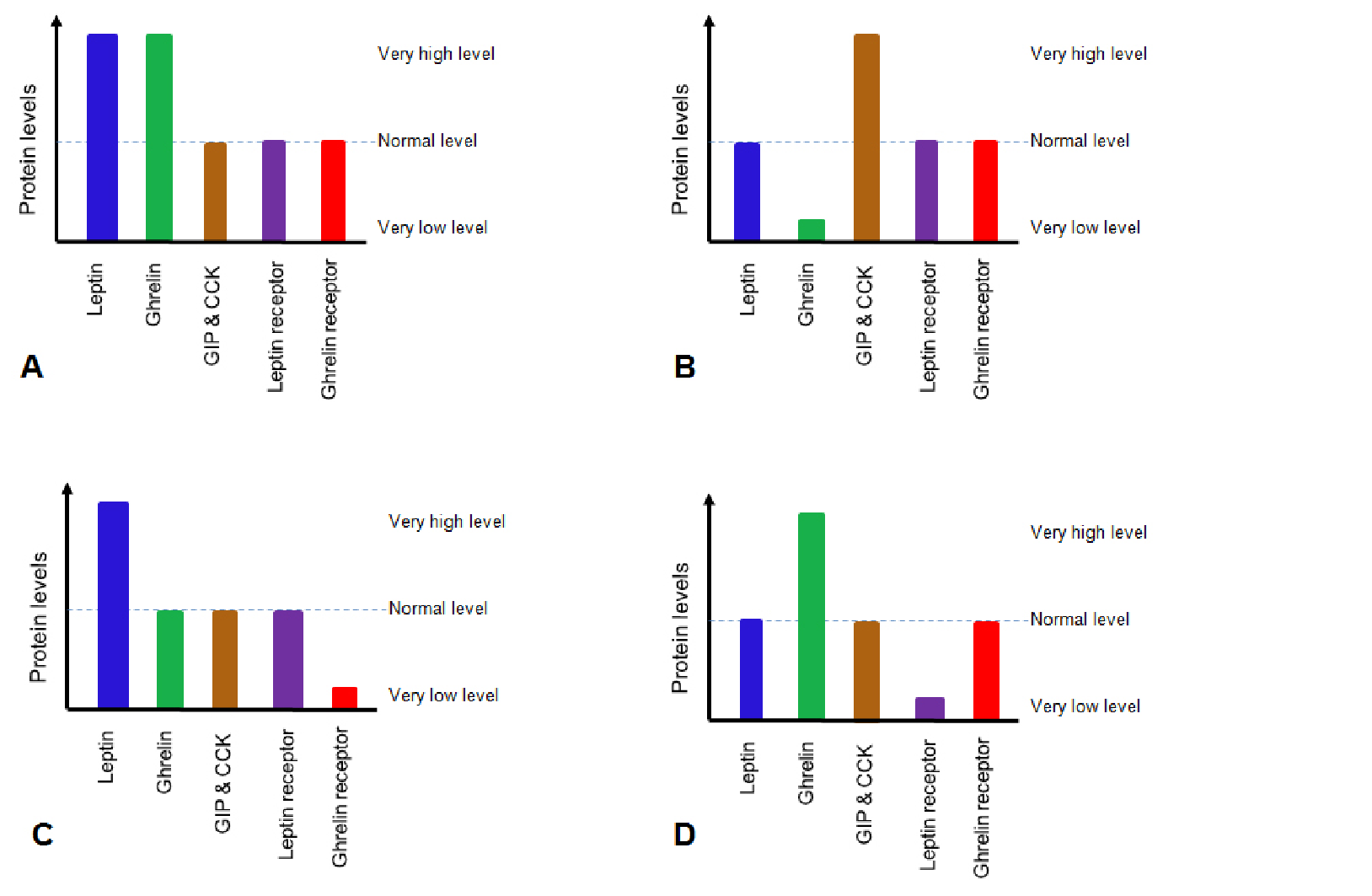Dr. Jones has just discovered that a patient who suffers from extreme obesity has abnormal levels of two different classes of proteins that regulate appetite. Select the most-likely protein profile for this patient from the below diagram.

A. A
B. B
C. C
D. D
Clarify Question
· What is the key concept addressed by the question?
· What type of thinking is required?
Gather Content
· What do you know about hormones that regulate appetite? What other information is related to the question?
Choose Answer
· Given what you now know, what information is most likely to produce the correct answer?
Reflect on Process
· Did your problem-solving process lead you to the correct answer? If not, where did the process break down or lead you astray? How can you revise your approach to produce a more desirable result?
D. D
Clarify Question
· What is the key concept addressed by the question?
o The question asks about hormones that regulate appetite.
· What type of thinking is required?
o You are being asked to analyze data to explain which hormones that regulate appetite could lead to obesity.
Gather Content
· What do you know about hormones that regulate appetite? What other information is related to the question?
o Leptin is secreted by adipose tissue and binds to leptin receptors in the hypothalamus. When leptin levels are high, they indicate that the animal is well fed and lead to a cessation of eating. The hormones GIP and CCK have receptors in the hypothalamus and seem to send the same kind of inhibitory signals to the brain as leptin. The gut hormone ghrelin has the opposite effect of these appetite-suppressing hormones. Ghrelin also has receptors in the hypothalamus, but ghrelin appears to stimulate food intake.
Choose Answer
· Given what you now know, what information is most likely to produce the correct answer?
o A decrease in hormones or their receptors that indicate an animal is well fed would increase feeding and obesity. Similarly an increase in hormones or their receptors that indicate that an animal needs to eat would lead to obesity. The combination proteins that would lead to obesity is example D – Ghrelin is increased which would stimulate feeding and leptin receptor is decreased which would remove some of the signals that an animal was well fed and did not need to eat more.
Reflect on Process
· Did your problem-solving process lead you to the correct answer? If not, where did the process break down or lead you astray? How can you revise your approach to produce a more desirable result?
o This question asked you to analyze data to explain which hormones that regulate appetite could lead to obesity. If you got the correct answer, great job! If you got an incorrect answer, where did the process break down? Did you realize that for obesity to occur proteins that suppress feeding would need to be inactivated? Did you realize that for obesity to occur proteins that stimulate feeding would need to be activated?
You might also like to view...
Now that the human genome has been sequenced, we know that there are fewer than expected protein
coding genes (approximately 20,000). Yet, the total number of proteins produced in humans approaches 100,000. What accounts for this discrepancy in numbers?
a. We have not yet identified all of the open reading frames in the human genome. b. We have not yet fully sequenced the human genome. c. The various mechanisms of mRNA processing lead to more proteins being produced than the DNA directly encodes. d. Some proteins are converted into completely new proteins after translation. e. There has been a gross over-estimation of the number of proteins produced in humans.
The underlying basis for an allergic reaction is ____
a. IgG production b. complement activation c. cytotoxic T cell activity d. over activity of mast cells e. IgA production
During which process would a cell plate form?
A) cytokinesis in an animal cell B) cytokinesis in a plant cell C) mitosis in an animal cell D) mitosis in a plant cell
Which of the following are associated with running injuries?
What will be an ideal response?